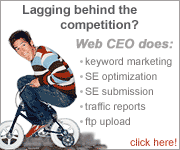Article Writing - A great way to get the word out about your product or website is through article writing. By creating articles with valuable content, you will not only attract the attention of people searching for information about your particular product or field, but the search engines absolutely love seeing a variety of well written, keyword optimized articles on your site.
Create articles that are accurate, truthful, helpful and specific and you will attract many more potential customers. Depending upon your budget, time, area of expertise and writing skills, you can either write your site’s articles yourself or pay others to write them for you. There are plenty of talented article writers out there ready to help you create your content. (The Digital Point forums or sites like eLance.com are a great way to find people willing to work for you.)
Blog Marketing - A blog (a contraction of the term weblog) is a type of website usually maintained by an individual with regular entries of commentary and descriptions of events. Think of it like a personal diary displayed on the web. Many bloggers are using video and images to increase their blog’s dynamics. In terms of marketing, many people have opted to create and develop blogs where they focus on a particular industry or topic as to position themselves as an expert in the field. Blogs provide a great opportunity for you to do the same! And network with others in the space.
Email Marketing - Email marketing is an excellent way to reach out to people interested in what you have to offer. And building a solid database is important. With this you can reach out to your audience directly and almost instantly. It’s a great way to build a relationship with your future, current and past customers.
Search Engine Marketing – Search Engine Marketing (also known as SEM) is the term used as you try to promote your website and its visibility by ranking higher in the Search Engine Results Pages (SERPS) through PAID means (that’s what differentiates this from Search Engine Optimizaiton). SEM includes Pay Per Click (PPC) and contextual advertising. The New York times defines SEM as “the practice of buying paid search listings.”
Pay Per Click Marketing – Pay Per Click (PPC) advertising can be found on search engines (like Google, Yahoo and MSN) as well as other sites such as blogs. Typically speaking, in PPC advertising, you only pay for the advertisement when your ad is clicked on by a user. The price you pay for that click (or the cost per click – CPC) will vary depending upon the competition in your field. The great thing about PPC advertising is that your marketing efforts can be extremely targeted as your ads are triggered only when a user searches for the keywords you have specified. PPC advertisements are often referred to as sponsored links or ads and appear on the top or sides of the organic search results (the results that naturally rank well).
Search Engine Optimization (SEO) – Search engine optimization (SEO) takes place when you try to improve the organic search engine rankings for a particular website. By creating search engine friendly content, optimized website tags and increasing the number of incoming links to your site, you are on your way to moving up the search engines. SEO is an art form of its own as it is important to understand the factors that search engines use to rank sites. For long term results, it is important to continually focus on the SEO of your site…because good search engine rankings equal FREE traffic.
Banner Ads – You’ve seen banner ads everywhere! If you don’t know by now, a banner ad is a graphic image used on websites to promote a product or service. Banner ads come in numerous sizes, but are often rectangles 460 pixels wide by 60 pixels high. Also 460 x 55 and 392 x 72 sizes are commonly used and more recently the 125 x 125 ad size has become popular for bloggers.
Pop Up Ads – I am positive that you have also viewed a good amount of pop up ads in the time you have spent online. Pop Up Ads are, of course, the advertisement windows that pop up after arriving at a site. They try to generate traffic or capture your email address. In recent years, this marketing tactic has become less popular since many online users now utilize pop up blocker technology. However, windows inside the site are still a great option.
Mobile Marketing – By setting up a short code and having users register for your SMS text messages, you can communicate effectively with your audience. You can also optimize your website so that it appears correctly on mobile phone browsers.
Social Media Marketing – According to Wikipedia, social media marketing is an engagement with online communities to generate exposure, opportunity and sales. The number one advantage is generating exposure for the business, followed by increasing traffic and building new business partnerships. Common social media marketing tools include Twitter, Blogs, LinkedIn, Facebook and YouTube.
If you want to take advantage of all of the benefits that Internet marketing provides you and your business, you'll only be successful if you have the real secret source of TRAFFIC. If you don't attract users, you won't be able to tell them about the products on your site that may fulfill their needs. Most importantly, you have to spur them to take action (whether this means providing their email address or purchasing a product). More traffic equals more money it's that simple. Even if you have the most beautiful website with all the functionality you could dream of, it does you AND consumers no good if they don't realize that you exist.


No comments:
Post a Comment